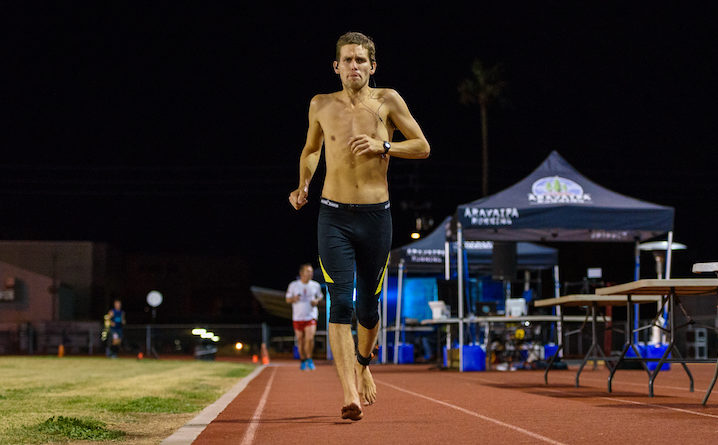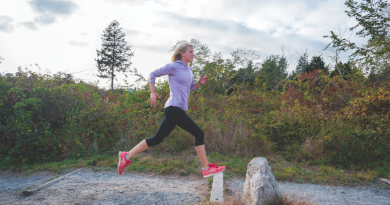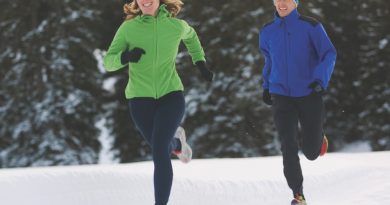Teage O’Connor Runs Wild
This field naturalist’s biggest ongoing experiment may be seeing just how far and fast he can fun—often barefoot.
Here are a few things you should know about Teage O’Connor: He is a vegetarian, but he has eaten a mink. He’s carved wooden spoons from more than 60 different species of trees. He was cast as Arnold Schwarzenegger’s son in “Kindergarten Cop.” He played a yeti in a film that debuted at Cannes. In 2017, he broke the record for running 100 kilometers barefoot. He was the fastest Vermonter in the 2017 Vermont City Marathon.
And he’s running it again this May.
With 10 weeks left before this year’s Vermont City Marathon, O’Connor pads around the house in Burlington he shares with his wife, Sophia Kruszewski, a policy specialist at the National Sustainable Agriculture Coalition (NSAC), his dog Boots and young son Cedar.
O’Connor is 5 feet 10, with a slender build and a race weight that hovers around 140 pounds. With light brown hair, a scruff of a beard and an innocently handsome face, he looks more 24 than 34. It’s March and there is still snow on the ground. His feet are bare. I glance down at them, expecting callouses and bunions.
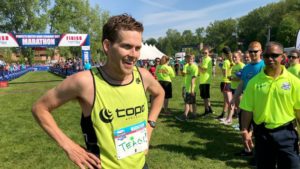
“After last fall I haven’t been running barefoot that much,” he says, lifting his feet up for a better look. They are long and bony, but other than a layer of floor grime, show few signs of wear and tear.
On August 13, 2017 around 5:00 a.m., O’Connor took off on the University of Vermont track determined to break the time record for running 100 kilometers barefoot. According to the Guinness Book of World Records, the record — 8 hours, 42 minutes and 11 seconds — was set by Peter Wayne Botha in Auckland, New Zealand in 2015.
O’Connor had two other goals for that day: one was to raise money for Crow’s Path, his nonprofit focused on outdoor education; and the other, to break his personal goal of running the 62 miles in under 7 hours.
Part of his training had been to run the Mt. Mansfield Double Up two weeks earlier, a rugged, 11-mile trail race around Mt. Mansfield with 5, 500 vertical feet and some near vertical climbing. Wearing Topo running shoes (he’s a Topo brand ambassador, and also sponsored by Honey Stinger), he won it handily, setting a course record of 2 hours and 12 minutes.
This would be O’Connor’s third run of 100 kilometers or longer. The first was a run he set out to do on his own while he was living in Chicago. Without using a map or having much of a fueling plan, he ran 70 miles from Chicago to Kenosha, Wisconsin.
The second was in 2008 at the Santa Barbara Tough Enough, a 65-mile run along the ridge of the Sierra that started as a relay race in 1986.
O’Connor, then 24, ran it solo. It was hot. He didn’t have a headlamp. He had no support team. He got lost and he bonked. But when he talks about the race and how brutal it was, he hesitates to mention this: He still won and his time of 9:23:19 stands as a course record.
BARE AMBITIONS
The morning of the 100K record attempt, O’Connor started out at a fast pace on the UVM track, a 6:25-minute mile, according to his detailed race report. At mile 8, Wandu Summu, a 15-year-old Burlington High School runner jumped in and tried to bring the pace down. They averaged a 6:38 pace for 11 miles.
“I really had no idea what to expect from my body when I made my plan. Whether my limit was a 6:30 or 7:30 pace was a total unknown, something only experience could determine. I’ve run ultras before, but always tend to go out fast and then bonk pretty hard,” he wrote.
O’Connor stopped twice to use the bathroom in the first two hours, and then ran straight, walking only occasionally.
“It was really hard to fight off my brain, which wanted to focus on how much it hurt and how easy it would be to stop,” he wrote.
Friends ran alongside to keep him motivated. Brian Pilcher, a masters national champion, jumped in and ran for a while and Salomon ultra-runner Kasie Enman, who holds the Vermont City Marathon record for a Vermont woman, came out too. At one point, more than 60 people showed up to cheer for him.
On the last lap, O’Connor was determined to break a 6-minute mile. He ran a 5:52 and finished just shy of his overall goal, coming in at 7 hours, 13 minutes, 25 seconds, shattering the world record by more than an hour.
Four months later, O’Connor ran the Desert Solstice in Phoenix, a 100-mile and/or 24-hour track race limited to 30 participants, representing some of the top distance runners in the country. O’Connor won that in 14:22:43—probably a world record, though no one has kept track of this.
“He was running against some of the best 24-hour racers in the country,” his coach Sam Davis says. “He probably could have continued, and he was winning—barefoot!” However, O’Connor developed a crack in his foot and stopped after 15 hours.
“When Teage runs barefoot, it’s not to be pretentious or show off. He’s remarkably humble, he just does it because it feels good to him,” says Davis, who has known O’Connor for more than 10 years and worked with him for the last three. “What he can do barefoot is unique. There are lots of people who want to run barefoot, but he’s one of the few who can do it. As a teacher and a naturalist, he observes nature in ways we don’t see. Being in touch with his body the way he is, running barefoot for him makes sense.”
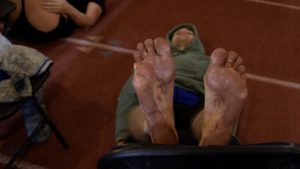
When I ask, “Why no shoes?” O’Connor shrugs. “One of the things I’ve enjoyed in running is challenging assumptions. One is that you can’t be vegan and be fast.” O’Connor has been primarily vegan for many years, though he now eats eggs and dairy. “Ethically, I’ve wanted to not eat meat, or to only eat meat that I have hunted.”
The other assumption: “That you have to wear shoes.”
Barefoot running was not a conscious decision, he says—he’s been running without shoes since 2006. After he started at University of Vermont’s field naturalist master’s program in 2008, he spent more time running on the indoor track barefoot. Gradually, he ran farther and ran outside, even in winter. His personal bests for the 5-mile, 5K and 10K are all barefoot. “Running barefoot has helped me improve my body mechanics,” he says, “but I don’t do it all the time. Your feet and body need to adapt to it.”
Another thing that has helped O’Connor is studying the gait of coyotes. “Dogs are pets. They know where their next meal is coming from and run mainly to play. If you watch them run, they sort of lumber all over the place. But watch a coyote, an animal that hunts for a living and has to be efficient; you’ll see how they put one paw in front of the other and how efficient their stride is.”
A naturalist, O’Connor has spent time not only watching coyotes and other animals, but trying to put himself in their shoes, so to speak. “I wanted to re-wild myself,” he says. “For a while, I was sleeping outside in my backyard in the winter.”
Ever the collector and log keeper, he set out on a mission to eat 100 different species, much of it road kill. “I ate voles, mice and road kill.” The strangest thing he ate was a bobcat (it was roadkill).
The most disgusting? A mink. “I’d made a big vat of coconut curry that I thought would hide the flavor, but when I put the meat in —it’s really oily—the whole thing tasted like skunk.”
Just inside his front door stands a rack with beautiful little wooden spoons he’s carved from various trees. His collection now includes more than 80 species.
When he is not teaching naturalist courses at Community College of Vermont (CCV), O’Connor runs his nonprofit, Crow’s Path, which has as its mission to “promote, foster, create and support direct, hands-on opportunities for people of all ages to reconnect to the natural world.”
Since founding it in 2009, O’Connor has taught kids winter survival courses and, for a while last year (2017), hosted monthly walks for adults in his “ID Club,” helping people to find and identify anything from wild flowers to fossils.
His personal blog, phyllotaxy.com, covers everything from glaciers in Vermont and wildlife tracking to running. It’s here that he keeps his personal running blog and race reports.
RUNNING WILD
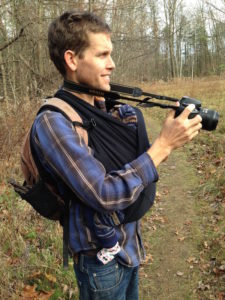
O’Connor grew up in Alaska surrounded by animals. His dad was a veterinarian and a competitive cyclist and his mom, an aspiring screen writer. “Even in kindergarten, I was running two or three miles a day,” he remembers. When O’Connor was 8, his dad died of cancer and he and his sister Meryl and their mother, Nina, moved to Thousand Oaks, Calif., outside of Los Angeles, so his mother could pursue screenwriting.
In second grade, O’Connor ran a 6:45 mile and began competing. “I fell in love with running. I loved being on the track and tallying the laps and how quantifiable running was. I’m such a collector,” he says with a wry smile. “I’d save every single ribbon from every race I entered.” In college, some friends jokingly gave him an award for being “Least Improved Since Second Grade.”
As his mother began to make her way in Hollywood, she signed Teage and his sister with an agent. He appeared in several commercials, and then was cast as one of the kids in “Kindergarten Cop.”
Teague was so good he was bumped up to a new role as Arnold Schwarzenegger’s son, a segment that was later cut. His other roles have been in his sister Meryl’s films, one of which, “The Ballad of Finn and Yeti,” was chosen from more than 1,500 short films to debut at Cannes in 2012. O’Connor, not surprisingly, played a yeti. “I’m a terrible actor,” he says, “But I’m good at dressing up and playing a wild thing.”
After going to University of Chicago, where he was an All-American in steeplechase, O’Connor began teaching at a school in the Bronx, N.Y. There, one day he picked up a book in the library, Winter World, by the award-winning writer, naturalist and professor emeritus at University of Vermont, Bernd Heinrich. “I read his work and decided, ‘I want to study this person, I want to think like he thinks.’”
He wrote to Heinrich, who had moved from Vermont to Maine. “To my surprise, he wrote a long letter back and encouraged me to apply to the University of Vermont field naturalist program, where he was still a visiting professor.” O’Connor had already applied. “That sealed it for me.”
O’Connor also signed up for Heinrich’s winter naturalist program and spent a January living with him far off the grid in the Maine woods. The two became friends. Heinrich is the author of the book Why We Run, which looks at what animals can teach us about running. Heinrich has held the record for 100K, 100-mile and 24-hour running races. His 100K record still stands.
“A few years ago, we went for a run near Bernd’s old home in Hinesburg,” O’Connor recalls. “Bernd was 68 at the time, and we’d run for a while and then he’d pause to point out a bird’s nest. I kept worrying the pace was too fast, but he kept picking it up, and by the end of 20 miles we were still at a 7-minute mile pace.”
Like Heinrich, O’Connor has married his naturalist eye for observing and documenting behavior with his training as a runner. “Every single training cycle is an experiment. I think of it as a longitudinal study of human capacity,” he says and he meticulously logs his runs. Whereas he used to run just based on instinct and did his first 70-mile run without food or even a watch or a map, he is now far more careful about his training and preparation.
“My first marathon, the Chicago Marathon in 2009, was one of the greatest races I’ve ever run. I was at 1:10:30 at the half and running with the lead pack. But I had no gels, I didn’t really know about fueling, and I bonked.” Still, he finished his first 26.2-miler in 2:23:26, just a minute and 26 seconds shy of automatically qualifying for the 2012 Olympic Trials.
On moving to Vermont, O’Connor began using a coach—first Jess Cover of RunVermont and now Sam Davis—and he has his eye set now on making the 2020 Olympic Trials, a tougher proposition since marathon qualifying times must be below either 2:19 for a marathon or 1:04 for a half. In April 2017, O’Connor raced in the U.S. Half Marathon Championships and finished 21st, with a time of 1:08:54. He’ll race the Half Marathon National Championships again in Pittsburgh on May 6. [Update: O’Connor finished 30th at the Nationals, with a time of 1:09:20]
“What really sets Teage apart is that he is fast at pretty much every distance, and that’s hard at his level to do,” says Davis. In 2016, O’Connor ran a 5k in 14:51 and a 10 mile in 53:04, both barefoot.
Now, O’Connor is switching back and forth between wearing shoes and running without them. His main goal is to make the Olympic trials, and that’s what Davis has been coaching toward.
“We did some testing and Teage’s VO2max is 64.7. While VO2max is a predictor of performance, it is not the predictor. Factors like running economy come into play. That said, for someone of Teage’s age, a VO2max greater than 59 would be considered Olympic caliber.”
“It’s been great to have a coach,” O’Connor says. “It takes so much mental energy to train and it can be so hard to get motivated to go for a 12-mile run in the winter when the weather is bad. There’s a saying that running is 90 percent physical and 10 percent mental. Well, racing is just the reverse, and having a coach has helped.”

